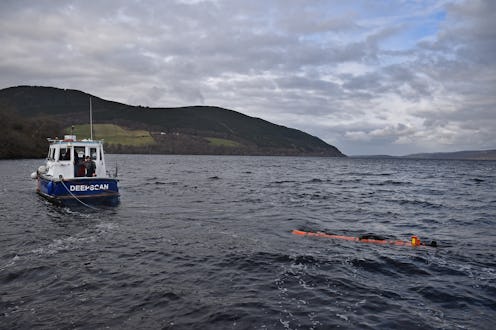Life
Scientists Will Use DNA To Try To Find The Loch Ness Monster & It Could Be A Huge Deal

We've all heard the lore of the mythical ~Loch Ness monster~. In a body of a water situated in Scotland, there's a myth that a prehistoric-looking dinosaur monster lurks beneath the surface — and it's stayed very much a myth for centuries, because no one has ever found the Loch Ness monster. It's all very exciting and mysterious. But now, science is stepping in to find out if Nessie is real: According to Reuters, scientists will try to find the Loch Ness monster with DNA beginning in June, because they finally got their priorities in order (I guess).
The legend of this not-so-lil' guy dates back quite a while, and contrary to popular belief, the legend rarely depicts the Loch Ness monster as a bad guy. The only reports of the so-called beast wreaking havoc on humanity like some blockbuster movie monster dates back to 565 A.D., when a missionary named Saint Columbia stopped by the fresh water lake in the Scottish highlands to battle a creature who had "been killing people in the lake," according to HISTORY. Sounds a lot like Jaws to me. Apart from that tale, there have been more reported (yet unproven) "sightings" than deaths linked to the myth of the creature.
People from around the world have been engulfed in debate over the mythical Loch Ness monster. A "primitive whale," the extinct "plesiosaurs," someone had an episode of sleep paralyzation and imagined the whole thing — the theories are endless. So now, whether you're a believer or not, scientists are going in — equipped with actual science to see if folklore is actually fact.
Investigations for the Loch Ness monster aren't newly dispatched. In the 1930s, tourists flocked to shores to catch a glimpse. Newspaper headlines called for the capture of the monster with a tantalizing reward of £20,000. Nessie was a hot commodity. But the evidence of existence didn't exactly have the whole world convinced.
Still, the curiosity has lingered and still remains for many when it comes to Nessie's humble abode. From 565 A.D. to 2018, the search continues. Reuters reported from London that "a global team of scientists plans to scour the icy depths of Loch Ness next month using environmental DNA (eDNA)." The experiment will occur in June 2018, and will hopefully provide an answer. Is Nessie home? Or, rather, was it ever?
The years may not have worn well on our beloved lake monster. In 2014, Live Science dug into the question of Nessie's possible death after no sightings were reported for over a year — the longest time span of zero shots of Nessie in 90 years. But it was concluded that most likely the monster was just being shy. Maybe it doesn't appreciate being identified as such? Just a guess. Alas, reports of a death and then more sightings arose in headlines. And now science is swooping in to settle things, as science does!
OK, so eDNA — what's cool about it? According to Reuters, team spokesman Professor Neil Gemmell said, "This DNA can be captured, sequenced and then used to identify that creature by comparing the sequence obtained to large databases of known genetic sequences from hundreds of thousands of different organisms." What they're looking for are tiny "fragments" of DNA from skin or urine or scales that have been left in Nessie's supposed swimming tracks.
If it's not Nessie that's discovered, it's expected that new species may be discovered instead — but a little smaller in scale to what you'd expect. Like, bacteria. That might not be as exciting as validating Nessie's existence but at least it's something. Whatever is found about the trails of the Loch Ness monster — or not — it's reported that we'll have answers very soon.